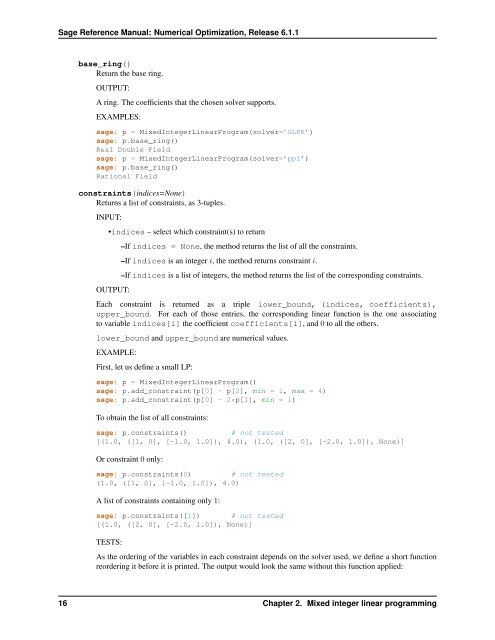Sage Reference Manual: Numerical Optimization - Mirrors
Sage Reference Manual: Numerical Optimization - Mirrors
Sage Reference Manual: Numerical Optimization - Mirrors
You also want an ePaper? Increase the reach of your titles
YUMPU automatically turns print PDFs into web optimized ePapers that Google loves.
<strong>Sage</strong> <strong>Reference</strong> <strong>Manual</strong>: <strong>Numerical</strong> <strong>Optimization</strong>, Release 6.1.1<br />
base_ring()<br />
Return the base ring.<br />
OUTPUT:<br />
A ring. The coefficients that the chosen solver supports.<br />
EXAMPLES:<br />
sage: p = MixedIntegerLinearProgram(solver=’GLPK’)<br />
sage: p.base_ring()<br />
Real Double Field<br />
sage: p = MixedIntegerLinearProgram(solver=’ppl’)<br />
sage: p.base_ring()<br />
Rational Field<br />
constraints(indices=None)<br />
Returns a list of constraints, as 3-tuples.<br />
INPUT:<br />
•indices – select which constraint(s) to return<br />
OUTPUT:<br />
–If indices = None, the method returns the list of all the constraints.<br />
–If indices is an integer i, the method returns constraint i.<br />
–If indices is a list of integers, the method returns the list of the corresponding constraints.<br />
Each constraint is returned as a triple lower_bound, (indices, coefficients),<br />
upper_bound. For each of those entries, the corresponding linear function is the one associating<br />
to variable indices[i] the coefficient coefficients[i], and 0 to all the others.<br />
lower_bound and upper_bound are numerical values.<br />
EXAMPLE:<br />
First, let us define a small LP:<br />
sage: p = MixedIntegerLinearProgram()<br />
sage: p.add_constraint(p[0] - p[2], min = 1, max = 4)<br />
sage: p.add_constraint(p[0] - 2*p[1], min = 1)<br />
To obtain the list of all constraints:<br />
sage: p.constraints()<br />
# not tested<br />
[(1.0, ([1, 0], [-1.0, 1.0]), 4.0), (1.0, ([2, 0], [-2.0, 1.0]), None)]<br />
Or constraint 0 only:<br />
sage: p.constraints(0)<br />
# not tested<br />
(1.0, ([1, 0], [-1.0, 1.0]), 4.0)<br />
A list of constraints containing only 1:<br />
sage: p.constraints([1]) # not tested<br />
[(1.0, ([2, 0], [-2.0, 1.0]), None)]<br />
TESTS:<br />
As the ordering of the variables in each constraint depends on the solver used, we define a short function<br />
reordering it before it is printed. The output would look the same without this function applied:<br />
16 Chapter 2. Mixed integer linear programming
















